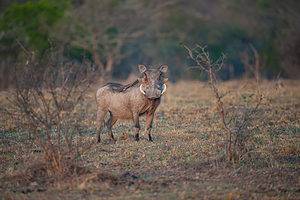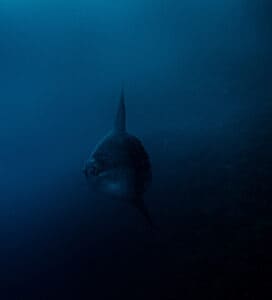Discover how wide the Klamath River is at its widest point. Appreciate the beauty that is unique to visit. The natural wonder is the second largest and longest scenic river that shares borders with Southern Oregon and Northern California. It is one of only three rivers that bisect the Cascade Mountain Range. The waterway is twisty, has varying depths between 8-50 feet, and and a constantly changing width variety depending which part of the river your near.
Klamath River is a breathtaking combination only nature can provide with not just scenic views but multiple recreational uses as well. The river flows approximately 263 miles through Oregon and Northern California in the United States.
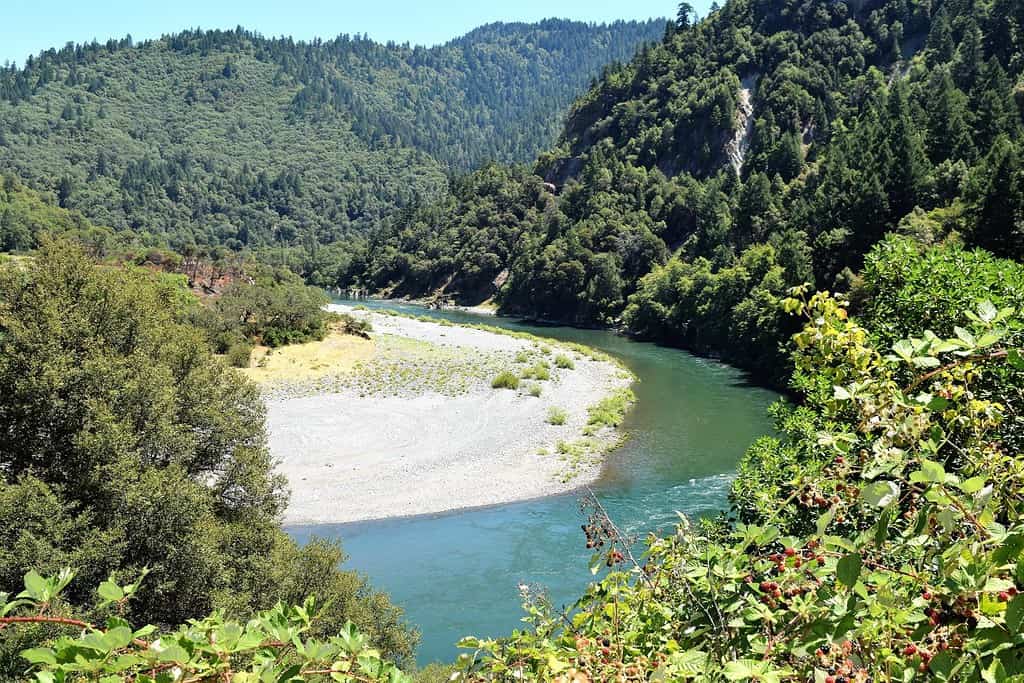
Klamath River, Oregon curves amid the deep forest with berry bushes in foreground.
©Rita Robinson/Shutterstock.com
Which Main Tributaries Supply the Klamath River?
Klamath River (the mainstem) gets initial water feed from Mount Shasta and rises above the Klamath River’s watershed. Three combined tributaries form confluence (point where a tributary meets the mainstem) points before the river ends in the Pacific Ocean. Oregon integrates water from a tributary called Salmon River which is a 33.5-mile river in the Cascade Range. Wooley Creek is a second tributary into the Klamath River and is a large stream in Siskiyou County, California. It is a tributary of the Salmon River as well. California also adds a Scott River tributary flow from North from the Marble Mountains to a final confluence with the Klamath River. The last part of the river waters journey is when it ends in the Pacific Ocean. The combination of the water from these 3 tributaries also supports some special qualities of the river wildlife.
How Large is the Klamath River?
The Klamath River is approximately 263 miles long. Discovering how wide the Klamath River is at its widest point can be a challenge as the width widely varies based on the area of the river you are standing. The Klamath River originates in Oregon and flow through the Cascade Mountain Range to the Pacific Ocean.
Which Main Tributaries Supply the Klamath River?
Klamath River (the mainstem) gets initial water feed from Mount Shasta and rises above the Klamath River’s watershed. Three combined tributaries confluence (point where a tributary meets the mainstem) together before the river ends in the Pacific Ocean. Oregon integrates water from a tributary called Salmon River which is a 33.5-mile river in the Cascade Range. Wooley Creek is a third tributary into the Klamath River and is a large stream in Siskiyou County, California. It is a tributary of the Salmon River as well. California also adds a Scott River tributary flow from North from the Marble Mountains to a final confluence with the Klamath River. The last part of the river waters journey is when it ends in the Pacific Ocean. The combination of the water from these 3 tributaries also supports some special qualities of the river wildlife.
How Does the Klamath River Compare to other Wild & Scenic Rivers in Oregon?
Klamath River at 26 miles is the longest Wild and Scenic River sharing a border between Oregon and California. Oregon designates 11 miles of the Klamath River as part of upper Klamath. Hands down, Oregon is one of the best places for whitewater rafting and lives up to its wild and scenic reputation. This twisty river is one of the 68 Federally-designated scenic and wild rivers and creeks in Oregon. Klamath River is an outstanding whitewater boating river with many Class III- IV+ rapids, warm water, and a long boating season. Other locations in Oregon, like the Rouge River, only has a 34 mile Wild section with predominantly Class III or less rapids.
Wildlife in the Klamath River
The Klamath River is home to a wide variety of wildlife. A wide variety of anadromous fish such as salmon and trout are plentiful. It is one of three rivers in the region. There are over 430 wildlife species, which includes 263 bird species, are observed in the basin.
Other surrounding wildlife to include are:
- A wide variety of waterfowl
- River otters
- Mink
- Mule deer
- Elk
- Pronghorn antelope
- Cougar
- Black bear
- Bald Eagles
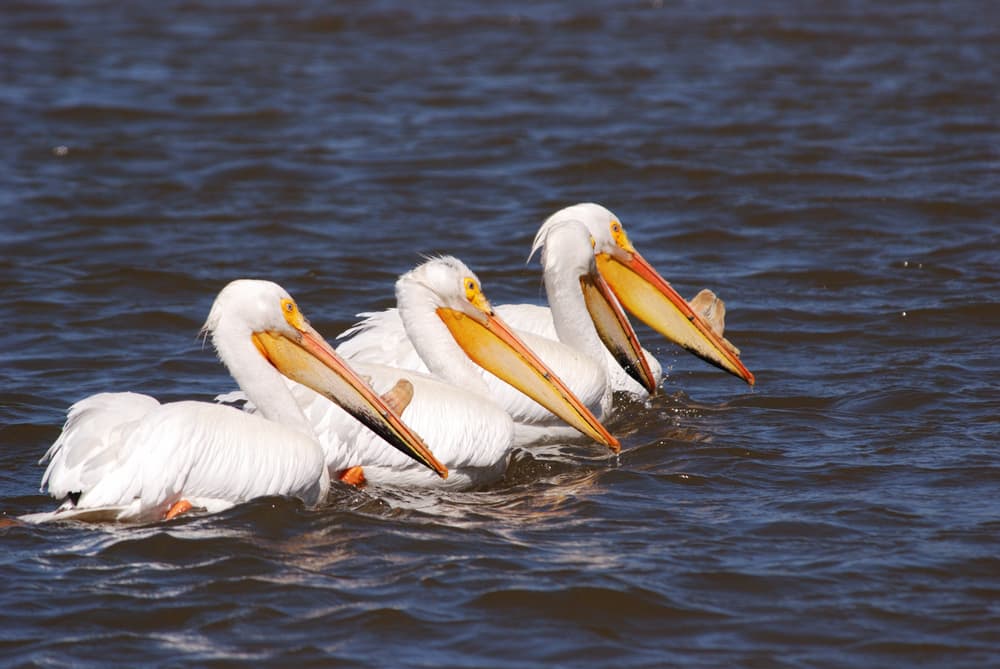
The American White
Pelican
,
Pelecanus erythrorhynchosare a species of waterfowl that grace the Klamath.
©TFoxFoto/Shutterstock.com
Why is the Klamath River Vital?
The Klamath River is a vital river, with multiple uses. It is broad uses include domestic, agricultural, and industrial water supply. As useful as this natural resource is, the vitality of the river is under constant stress. It is impaired by nutrients and organic enrichment that results from grazing, dairies, and irrigated agriculture in the upper watershed. The Klamath River is a natural resource, and the attributing tributaries are also great producers of gold. It can be found in the gravels of the river’s stream channels.
The Klamath River is best known for its overall cold and warm water fish population and fisheries. The Klamath River Basin supports many types of salmon which include chinook, coho, and steelhead salmon. The river has some of the largest rainbow trout in the world. It is a home to many anadromous (migrating up rivers from the sea to spawn) species. One of the river’s claims to fame is the state-managed wild rainbow trout fishery amongst other multiple fisheries in the area. The combination of tributaries helps to directly support a genetically unique population of rainbow trout. They are able to survive the naturally high temperatures and acidity of the river.
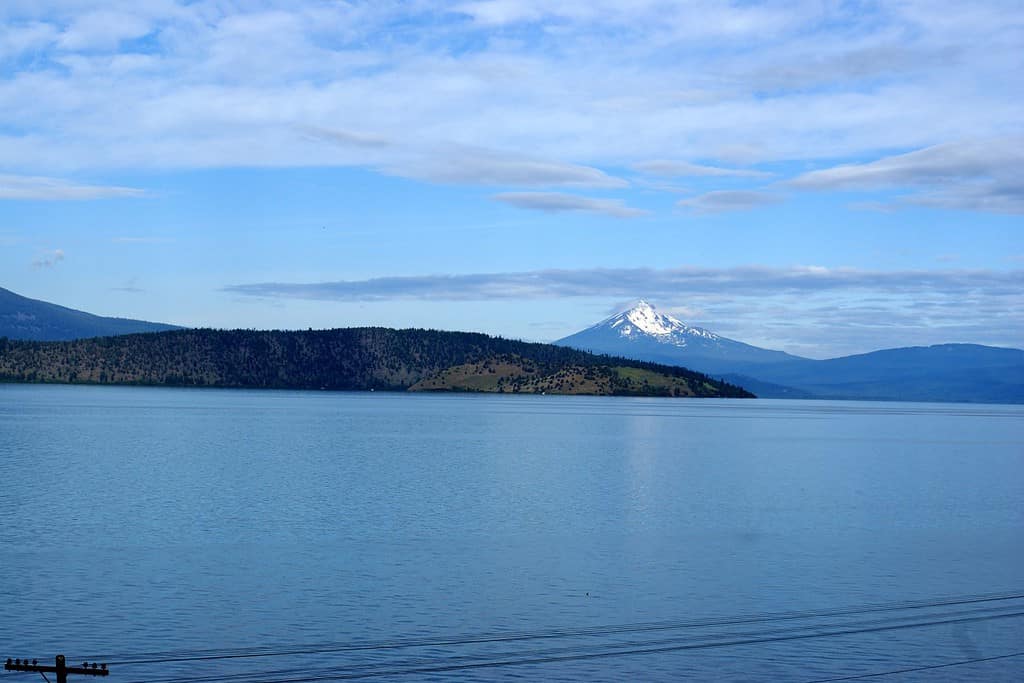
The Klamath is scenic from many viewpoints. This picture shows a clear view of the snow covered peak of Mt. McLoughlin in background.
©Gurcharan Singh/Shutterstock.com
Klamath River Conservation Efforts
The Klamath River has many nature conservation efforts within the Oregon and California borders. In 2005 Oregon and California created The Klamath Basin Restoration Agreement (KBRA), and started to make determinations on river usage and water rights involving the Klamath River and Klamath Basin. Congress failed to pass legislation by the set deadline that would implement the KBRA by the January 1, 2016. On April 6, 2016 a new agreement, the Klamath Hydroelectric Settlement Agreement (KHSA) was signed . By removing 4 of the hydroelectric dams (the Copco 1, Copco 2, J.C. Boyle, and Iron Gate), is more than 400 miles of natural habitat expected to reopen to the wildlife. These efforts will specifically help steelhead and other threatened and iconic fish, and restore flows that can better flush away toxic algae and disease.
Where is Klamath River Located on a Map?
The Klamath River is located near and through the southern Oregon border and flows into California. The river cuts through the Cascade Mountain Range and the Klamath Mountains before entering the Pacific Ocean in northern California. The rivers and lakes in Oregon are vast with the Klamath River one of the main highlights.
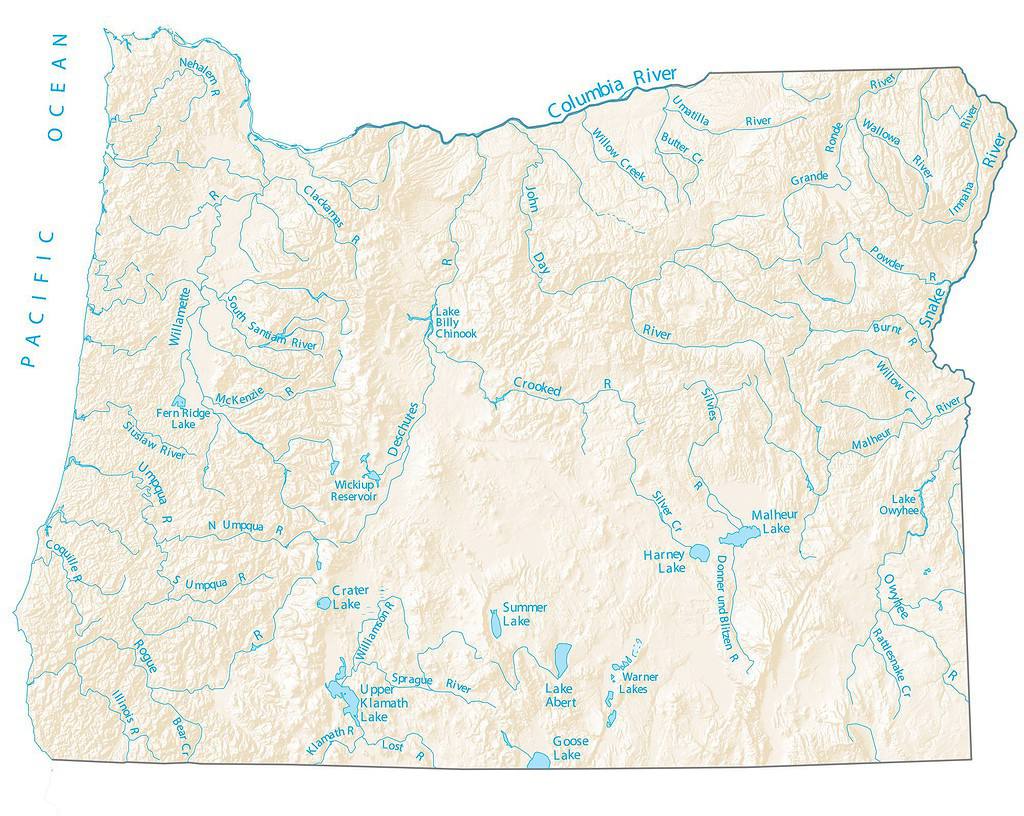
Oregon has multiple lakes and rivers. Oregon Lakes and Rivers Map by
GISGeography
and last updated on October 26, 2023.
©By: GISGeography – License
The photo featured at the top of this post is © Victoria Ditkovsky/Shutterstock.com
Thank you for reading! Have some feedback for us? Contact the AZ Animals editorial team.



